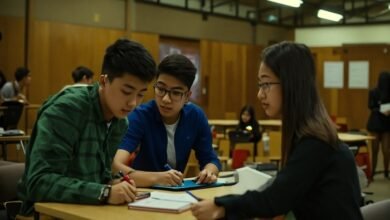Special Educational Needs: A Comprehensive Guide

Special Educational Needs In today’s diverse educational landscape, understanding and addressing special educational needs (SEN) is paramount for ensuring inclusive and equitable learning environments. From cognitive disabilities to physical impairments, SEN encompasses a wide range of conditions that require tailored support and interventions. In this comprehensive guide, we delve into the intricacies of special educational needs, exploring the various types, effective strategies for support, and the importance of inclusive education.
What are Special Educational Needs (SEN)?
Special Educational Needs, often abbreviated as SEN, refer to individualized learning requirements arising from disabilities or difficulties that impact a person’s ability to learn and participate in education. These needs can manifest across various domains, including cognitive, sensory, physical, behavioral, and emotional areas. Common examples of SEN include dyslexia, autism spectrum disorders, attention deficit hyperactivity disorder (ADHD), and physical disabilities.
Different Types of SEN
1. Cognitive Disabilities : Cognitive disabilities such as dyslexia, dyscalculia, and specific learning disorders affect an individual’s ability to process information, acquire literacy and numeracy skills, and comprehend academic concepts.
2. Physical Disabilities : Physical disabilities encompass a broad spectrum of conditions, ranging from mobility impairments to chronic health conditions. These disabilities may necessitate accommodations such as wheelchair access, assistive technology, and modified learning materials.
3. Sensory Impairments : Sensory impairments include visual impairments, hearing loss, and other sensory processing disorders that affect an individual’s perception and interaction with the environment. Specialized support and resources such as Braille materials and sign language interpreters are essential for accommodating students with sensory impairments.
4. Social, Emotional, and Behavioral Difficulties (SEBD) : SEBD encompass a range of emotional and behavioral challenges that can impact a student’s social relationships, self-regulation, and academic performance. Effective interventions may involve counseling, behavior management strategies, and social skills training.
Read more about : dorado tarde
Strategies for Supporting Individuals with SEN
1. Individualized Education Plans (IEPs) : IEPs are tailored educational plans designed to meet the unique learning needs of students with SEN. These plans outline specific goals, accommodations, and support services to facilitate academic progress and inclusion within mainstream classrooms.
2. Differentiated Instruction: Differentiated instruction involves adapting teaching methods, materials, and assessments to accommodate diverse learning styles and abilities. Teachers can employ multisensory techniques, visual aids, and flexible grouping strategies to cater to the individual needs of students with SEN.
3. Assistive Technology: Assistive technology tools such as text-to-speech software, graphic organizers, and adaptive devices empower individuals with SEN to access curriculum content, participate in classroom activities, and demonstrate their learning effectively.
4. Collaboration and Communication: Effective collaboration among educators, parents, support staff, and healthcare professionals is essential for developing comprehensive support plans and fostering a cohesive support network for students with SEN. Open communication channels facilitate the sharing of insights, concerns, and best practices to optimize learning outcomes.
Read more about : call bomber
The Importance of Inclusive Education
Inclusive education emphasizes the principle that all students, regardless of their abilities or differences, have the right to access quality education within mainstream settings. By embracing diversity, promoting acceptance, and accommodating individual needs, inclusive schools cultivate a culture of respect, empathy, and belonging for students with SEN.
Inclusive education not only benefits students with SEN by fostering their academic and social development but also enriches the learning experiences of their peers. Through collaborative learning environments, students gain valuable insights into diversity, empathy, and mutual respect, preparing them to thrive in an increasingly diverse society.
Conclusion
Understanding and addressing special educational needs is essential for creating inclusive learning environments where every individual can thrive and reach their full potential. By recognizing the diverse needs of students with SEN, implementing effective support strategies, and promoting inclusive practices, educators and stakeholders can nurture a culture of equity, diversity, and inclusion in education.
Whether through individualized interventions, collaborative partnerships, or systemic reforms, the journey towards inclusive education begins with a collective commitment to honoring the unique strengths and challenges of every learner.
Read more about: downloadhub4u
FAQ (Frequently Asked Questions)
1. How are special educational needs identified?
Special educational needs are identified through comprehensive assessments, observations, and collaboration among educators, parents, and specialized professionals. These evaluations help determine the nature and extent of support required to address the individualized learning needs of students.
2. What role do parents play in supporting students with SEN?
Parents play a crucial role in advocating for their child’s needs, collaborating with educators to develop appropriate support plans, and providing ongoing encouragement and reinforcement at home. Their involvement and input are integral to the success of inclusive education initiatives.
3. How can schools promote a culture of inclusion and acceptance?
Schools can promote a culture of inclusion and acceptance by implementing inclusive policies and practices, fostering positive peer relationships, celebrating diversity through multicultural education, and providing professional development opportunities for staff to enhance their understanding of special educational needs.
4. What resources are available for educators working with students with SEN?
Educators working with students with SEN can access a wide range of resources, including professional development programs, assistive technology tools, specialized training materials, and online communities for sharing best practices and strategies.
By addressing these frequently asked questions and embracing a collaborative, student-centered approach, stakeholders can work together to create nurturing and inclusive learning environments where every individual has the opportunity to thrive and succeed.
This concludes our comprehensive guide to special educational needs, highlighting the importance of understanding, supporting, and championing the diverse abilities and potential of every learner.
Read more about: guiterly





